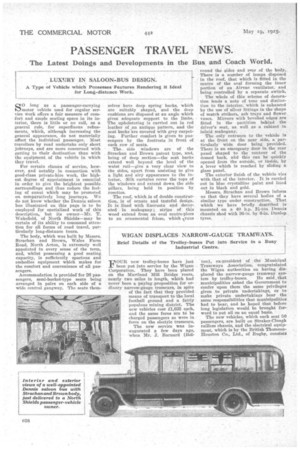PASSENGER TRAVEL NEWS.
Page 22

If you've noticed an error in this article please click here to report it so we can fix it.
The Latest Doings and Developments in the Bus. and Coach World.
LUXTRY IN SALOON-BUS DESIGN.
A Type of Vehicle which Possesses Features Rendering it Ideal for Long-distance Work.
S0 long as a passenger-carrying motor vehicle used for regular service work offers a fair measure of comfort and ample seating space in its interior, there is little or no call, as a general rule, for superfluous refinements, which, although increasing the general appearance, do not materially affect the individual passenger. Most travellers by road undertake only short journeys, and are more concerned with getting to their destination than with the equipment of the vehicle in which they travel.
For certain classes of service, however, and notably in connection with good-class private-hire work, the highest degree of appointment is essential in order to give the brightest possible surroundings and thus reduce the feeling of ennui which may be promoted on comparatively long journeys. We do not know whether the Dennis saloon bus illustrated on this page is to be employed for specialized work of this description, but its owner—Mr, T. Wakefield, of North Shields—may be certain of its ability to command attention for all forms of road travel, partieularly long-distance tours.
The body, which was built by Messrs. Strachan and Brown, Wales Farm Road, North Acton, is extremely well appointed in every sense of the term, and, whilst possessing a good seating capacity, is sufficiently spacious and embodies equipment which makes for the comfort and convenience of all passengers.
Accommodation is provided for 26 passengers, semi-bucket-type seats being arranged in pairs on each side of a wide central gangway. The seats them selves have deep spring backs, which are suitably shaped, and the deep cushions are disposed at an angle which gives adequate support to the limbs. The upholstering is carried out in red leather of an antique pattern, and the seat backs lire covered with grey carpeting. Further comfort is given to passengers by the footrests in front of each row of seats.
The side windows are of the Strachan and Brown patent type, and, being of deep section—the seat backs extend well beyond the level of the waist rail—give a very clear view to the sides, apart from assisting to give a light and airy appearance to the interior. Silk curtains cover the tops of the windows and extend down the side pillars, being held in position by rosettes.
The roof, which is of double construction, is of ornate and tasteful design. It is lined with linerusta and decorated in mahogany; strips of this wood extend from an oval centre-piece to an ornamental frieze, which ‘runs
round the sides and rear of the body. There is a number of lamps disposed in the roof, that which is fitted in the centre of the oval forming the inner portion of an Airvac ventilator, and being controlled by a separate switch.
The whole of this scheme of decoration lends a note of tone and distinction to the interior, which is enhanced by the use of silver fittings in the shape of match strikets, ash trays and flower vases. Mirrors with bevelled edges are fitted in the partition behind the driver's seat, as well as a cabinet in inlaid mahogany.
The only entrance to the vehicle is at the front on the near side, a particularly wide door being provided. There is an emergency door in the rear panel shaped to the contour of the domed back, add this can be quickly opened from the outside, or inside, by a lever which is reached by sliding a glass panel. The exterior finish of the vehicle vies with that of the interior. It is carried out in blue crystalline paint and lined out in black and gold.
Messrs. Strachan and Brown inform us that they have several bodies of a similar type under construction. That which we have briefly described is mounted on a 40 h.p. 2i-ton Dennis chassis shod with 36-in. by 6-in. Dunlop tyres.




























